Angelfish
IDENTIFICATION GUIDE
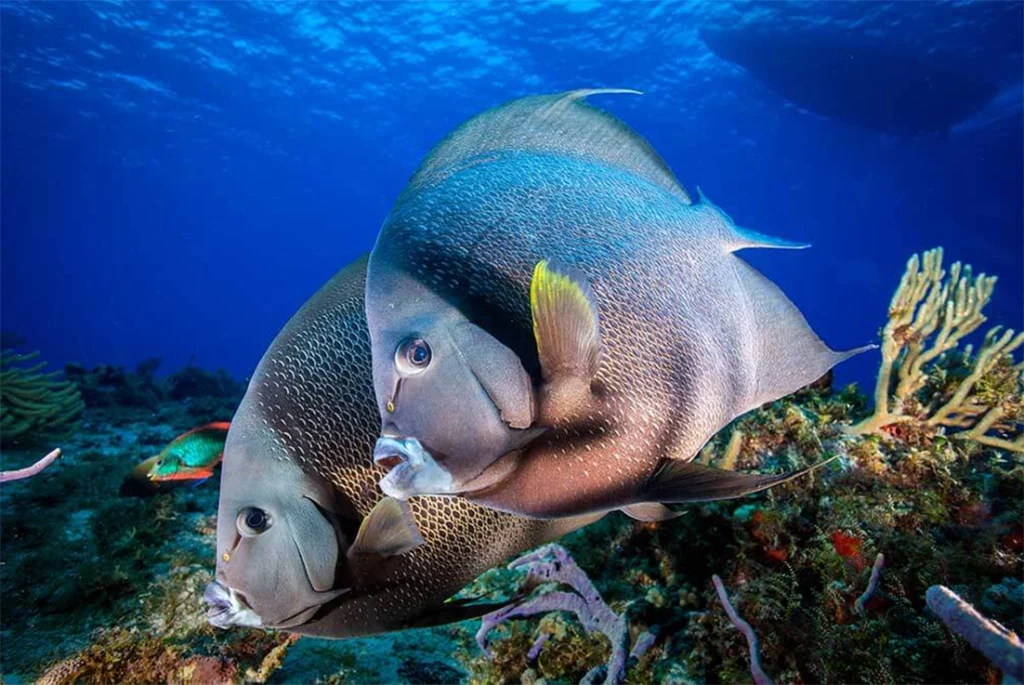
ANGELFISH IDENTIFICATION
Angelfish found in the Caribbean are thin and oval-shaped with adults often grow larger than 30cm/1ft. Designation is simplified by their long, distinctive dorsal and anal fins. Furthermore, each species exhibits a distinct and ever-changing palette of colors and patterns on their scales simplifying angelfish identification.
All angelfish have a spine, called a preopercle, on the bottom of their operculum (gill cover). Additionally, they also exhibit a slightly rounded and protruding forehead with a tiny mouth which is perfectly suited to tugging off algae and coral polyps from the reef.
Each species varies in their social behavior with some preferring solitude while others form groups typically consisting of one male and multiple females, forming a social structure centered around mating. These marine angelfish differ significantly from their freshwater relatives with regards to how they reproduce. Freshwater angelfish will lay eggs in nests. Their saltwater cousins release them into the ocean where they float and blend into the plankton. Sadly this makes them vulnerable to being eaten by plankton-feeding animals such as krill, copepods and even whale sharks. As a result, this high predation rate means that most of the eggs do not survive long enough to hatch.
Angelfish are named after their unique and distinctive body configuration which resembles an angel when viewed from the side. The long, flowing fins – specifically the dorsal and anal fins – further enhance this resemblance and assists in angelfish identification. These fins often stretch wide like the wings of cherubs beings when the angelfish swims or hovers in the water. Additionally, their shimmering scales, which can appear in various colorful and iridescent hues, contribute to their celestial and heavenly appearance, reminiscent of the angels often depicted in religious art. This angelic resemblance is pronounced further when they’re viewed in their natural underwater habitat, gracefully soaring above the reef.
Angelfish identification experts have found 86 destinct species of saltwater angelfish, categorized into 7 different genera within the Pomacanthidae family. These species are distinct to marine environments and should not be mixed up with freshwater angelfish. Saltwater angelfish are notably prominent on coral reefs. Six (if we include the Townsend Angelfish) of these species can be found in the Caribbean:
BERMUDA BLUE ANGELFISH
Holacanthus bermudensis
Spanish: Isabelita Azul
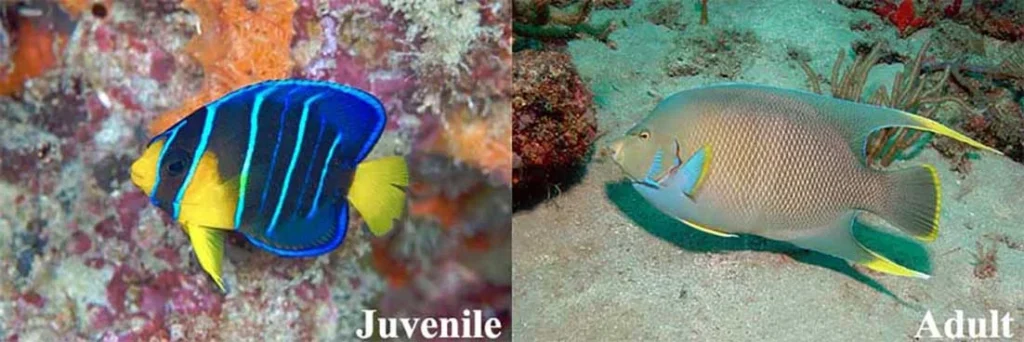
Typically 20-35cm (8-14in.) in length but can grow as big as 45cm (18in.). Tail and pectoral fins bordered in yellow with no crown on the forehead. Juvenile: Middle turquoise body bar is straight.
The Blue Angelfish, known scientifically for its radiant bluish hues, exhibits a variety of fascinating characteristics. During its juvenile stage, the fish displays several vertical stripes with three being especially prominent and bright. As a result, these three stripes distinguish it from the queen angelfish which will have at least four. As it matures, the stripes fade and the fish develops a predominantly bluish-brown coloration across its body, giving it it’s name. The edges of its scales take on a subtle yellowish hue, complemented by yellow rims on its tail and fins. One distinctive feature of adult Blue Angelfish is the elongated filament on its dorsal fin. It is notably longer than the filament on its anal fin and is theorized to signal health or genetic fitness.
Found predominantly off the coast of Florida, divers also frequently spot it here in Cancún and the Riviera Maya. Juveniles prefer shallower waters like bays and inshore reefs but adults will venture out to deeper reefs to find home. Their diet mainly consists of sponges and small invertebrates.
They are often observed to form breeding pairs which, on rare occasions, may include a member from the visually similar Queen Angelfish species. The extremely rare offspring of these two species, Townsend Angelfish, vary in both color and markings. This hybrid shares physical traits predominately with Blue Angelfish but the crown-like marking inherited from Queen Angelfish makes it distinguishable.
FRENCH ANGELFISH
Pomacanthus paru
Spanish: Guinea
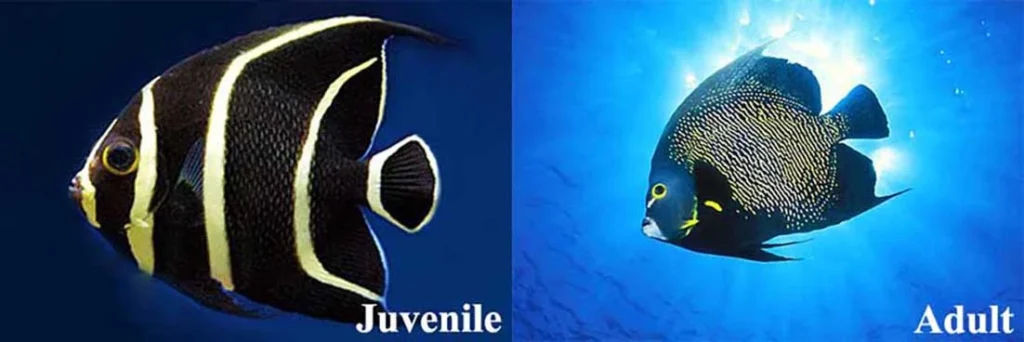
Typically 25-35cm (10-14in.) in length but can grow as big as 45cm (18in.). Black scales with yellow tips. Eye ringed in yellow. Juvenile: the rounded tail is bordered in yellow.
The French Angelfish is found along the western Atlantic coast from as far north as New York and the Bahamas to Brazil in the south. They are also often sighted around the Caribbean’s eastern islands such as the Antilles and Roatan. Furthermore, they have also been observed inhabiting the eastern Atlantic from around Ascension Island and St. Paul’s Rocks. They are habitually seen at depths of between 2m/7ft and 100m/330ft.
These angelfish are usually seen in pairs on shallow reefs swimming in close proximity to fan coral. They do feast on a relatively wide range of food including algae, bryozoans, zoantharians, alcyonacea and tunicates. However their main source of nutrition is sponges which constitute roughly 70% of the species’ diet but since sponges are plentiful, the fish are normally well fed.
Juveniles tend cleaning stations where they service a broad range of clients, including jacks, snappers, morays, grunts, surgeonfish, and wrasses. At the station the cleaner flutters its pectoral fins and thus signals that he is open for business. Then, when cleaning, it touches the clients with its pelvic fins.
The adult background coloration is a very dark blue but the scales of the body, except those at the front from nape to abdomen, are rimmed with golden yellow. Furthermore, the pectoral fins have a broad orange-yellow bar, the dorsal filament is yellow, the chin is whitish, the outer part of the iris is yellow, and the eye is narrowly rimmed below with blue. Juveniles are black with vertical yellow bands.
Spawning pairs are strongly territorial and usually both partners defend vigorously their territory against neighbouring pairs. During the day you will mostly see these fish out and about, but come night they will seek out shelter in their designated hiding spot which they return every night.
Their flesh considered to be of good enough quality for human consumption. It is marketed fresh in Singapore and Thailand, however it has been linked to ciguatera poisoning which is a severe form of food poisoning which can last up to 20 years. This fish has also been successfully raised in captivity. Highly prized for public and private aquaria, the French angelfish is a very hardy, long-lived, and disease-resistant species.
GRAY ANGELFISH
Pomacanthus arcuatus
Spanish: Cachama Blanca
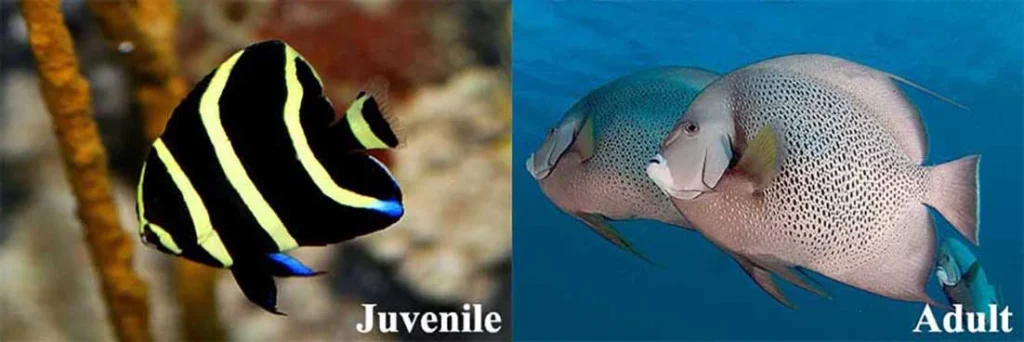
While some individuals may grow as large as 60cm or 24 inches, most males will grow to be approximately 45 cm or 18 inches in length.
These thin, oval fish have long dorsal and anal fins which can sometimes trail out past their tail fin. They are a beautiful shade of gray with dark specks on each scale, and white jaws. Juveniles have five yellow bands on each side running vertically over a black body. They will slowly change to a uniform gray as their rounded fins also become more angular over time. These reef fish have been seen developing long-term monogamous breeding pairs. They are very popular with both reef divers and photographers due to the curiosity. Unfortunately this also makes them easy prey and they are often spearfished for food.
Typically spotted with a partner, these Grey Angelfish form long-term monogamous breeding pairs which inhabit reefs with a depth of approximately 2-30m (7-98ft). They do this because these reefs found in this depth range provide optimal hiding places and so they avoid becoming prey for predators. Interestingly, they were also one of the first inhabitants of the underwater museum; schooling in small groups near The Banker. Presently, their numbers at the Musa have dwindled and are more likely found in mating pairs at Silent Evolution. Juveniles seem to prefer small shallower reefs heads with surrounding grassy areas.
The females spawn from April until September, usually on the deeper areas of the reef and beginning just before sunrise. Couples will glide 1-2m (3-6ft) above the reef with a few quick dashes up into the water column. If an unaccompanied individual tries to approach the pair, they are very quickly chased away. When they are finally ready, the pair will swim slowly, rising in the water column, and bring their vents close together before releasing eggs and sperm into the water. During each reproduction cycle, which is repeated numerous times over the 6 months, 25,000-75,000 eggs are released. Larval Grey Angelfish are believed to hatch approximately 15-20 hours after fertilization. They will then find homes in beds of floating plankton until they reach around 15mm when they’ll settle onto the coral reef.
Juvenile gray angelfish are visually similar to French Angelfish but can be distinguished by observing their tail and eyes. Gray angelfish feature transparent filaments on the very end of its tail. On its French counterpart these filaments are colored a bright yellow. If the tail’s hidden, yellow bands around the Gray Angelfish’s eyes can also distinguish it from the French.
QUEEN ANGELFISH
Pomacanthus ciliaris
Spanish: Guinea
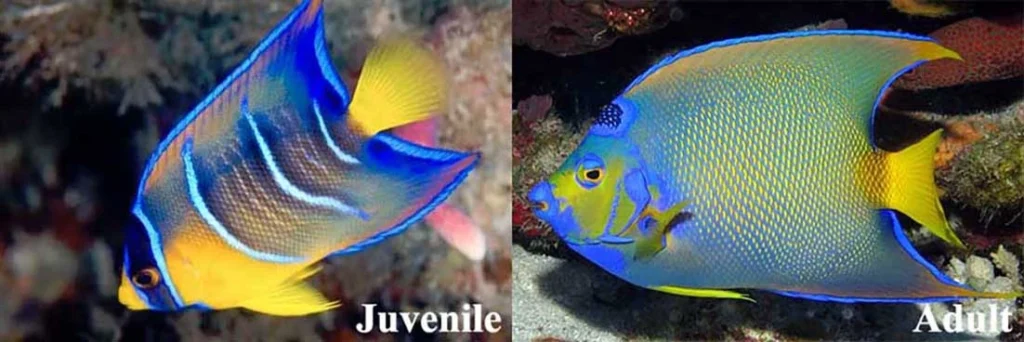
Usually 20-36cm (8-14in.) in length but can grow as big as 45cm (18in.). Dark blue “crown” on forehead is flecked and ringed with brilliant blue. The juvenile is identified by curved turquoise body bars. Residing on offshore reef, they perform cleaning services for other fish, removing bothersome parasites.
During its early stages of development, the juvenile Queen Angelfish presents a predominantly dark blue body with contrasting bright yellow on the pectoral fins, tail, and mouth areas. Notably, these young fish display multiple fluorescent blue vertical stripes along their sides.
As they mature, they transition into a striking colorful oval-shaped fish with trailing dorsal and anal fins and a wedge-shaped tail. Their ventral and pectoral fins retain the vivid yellow coloration, while their lips become a dark blue and their face turns yellow. The dorsal and anal fins are particularly colorful, exhibiting a rich blend of blue, yellow, and occasionally pink hues. It can be distinguished from the similar Bermuda Blue Angelfish by the conspicuous dark “crown” on its forehead.
Except for its long term breeding mate, these fish seem to be somewhat unsociable and keep away from all other members of the Pomacanthidae family. Nevertheless, though they may also exhibit initial shyness around divers, Queen Angelfish are known to return after retreating to watch us from a short distance, showing a curious nature toward human observers.
Usually found near the bottom of coral reefs, they spend their day eating sponges. algae and some marine invertebrates. They are harvested commercially but only for aquarium hobbyists and not as a food source. The reason for this is that human consumption of this fish has been linked to cases of ciguatera poisoning.
Ciguatera poisoning is triggered by the accumulation of ciguatoxins in the meat of tropical marine fishes. Ciguatoxins are manufactured by marine dinoflagellates that fix themselves to marine algae and thus may be incidentally consumed by herbivorous fish. Bigger piscivorous reef inhabiting fish who occupy the top of the food chain become reservoirs for the greatest amounts of ciguatoxin by consuming other fish on the reef. Humans who suffer ciguatera poisoning may suffer from gastrointestinal issues which may last anywhere from several days to several years and in extreme cases as much as 20 years. Other symptoms include a general weakness in their arms and legs, and a reversal in the ability to differentiate hot versus cold. The illness is serious anybody displaying symptoms should seek out a doctor immediately.
ROCK BEAUTY
Pomacanthus tricolor
Spanish: Isabelita Medioluto
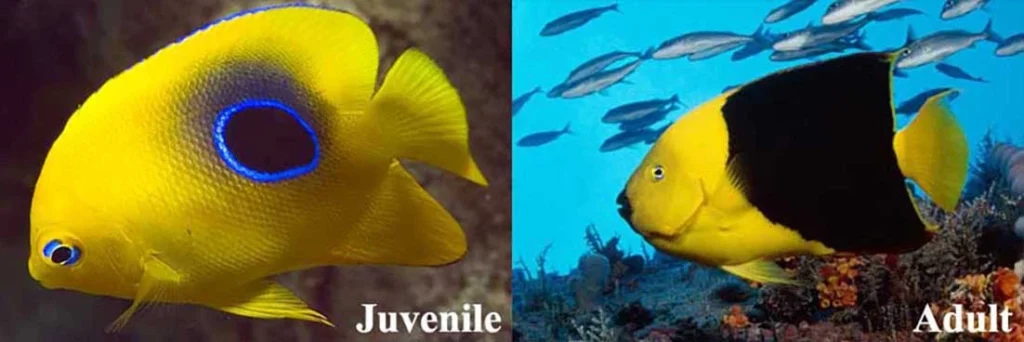
Typically 13-20cm (5-8in.) in length but can grow as big as 30cm (12in.). The fore body and tail are a bright yellow while the mid and rear are black. Blue markings both above and below pupil. Juvenile fish have a dark black spot ringed in brilliant blue on rear body which expands as the fish gets older.
This easily identifiable reef fish is very protective of its home and seldom leaves the small area which it has lain claim to. Instead this fish patrols its territory and challenges almost all other Rock Beauties which may stray into its domain. The only exception being its mate with which it builds a long lasting monogamous relationship. It has a flat, oval black body with exaggerated black dorsal and anal fins (with yellow and orange fringes) and a yellow tail and face with dark lips. The juvenile is nearly entirely bright yellow, with a dark blotch on both flanks which slowly develops until it has enveloped the majority of its body. Despite difficult to maintain, these angelfish are often sold to home aquariums due to their bright and beautiful colouration. They are however very rarely hunted for human consumption.
Often mating pairs can be seen to consist of both a large and a small individual suggesting a sexual dimorphism exists in the species. Nevertheless there is no difference in the coloration of either sexes. The pair reproduces by gradually ascending side-by-side up into the water column and releasing large sums of semen and eggs into the water. The female can release up to 75 thousand eggs each day around sunset, and as many as ten million eggs during each spawning cycle. The eggs are translucent, globular, and pelagic (remains in the water column and doesn’t sink to the bottom), each comprising a small drop of oil for buoyancy. The eggs hatch sometime between 15 to 20 hours after fertilization.

